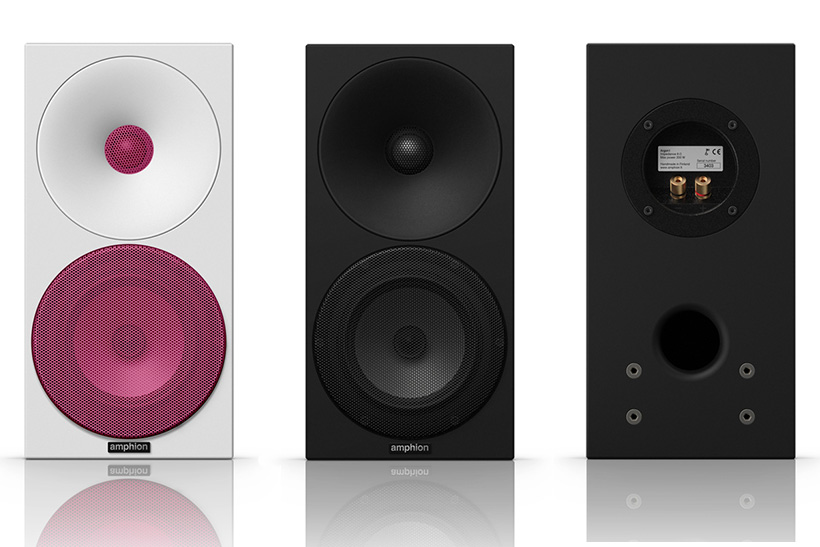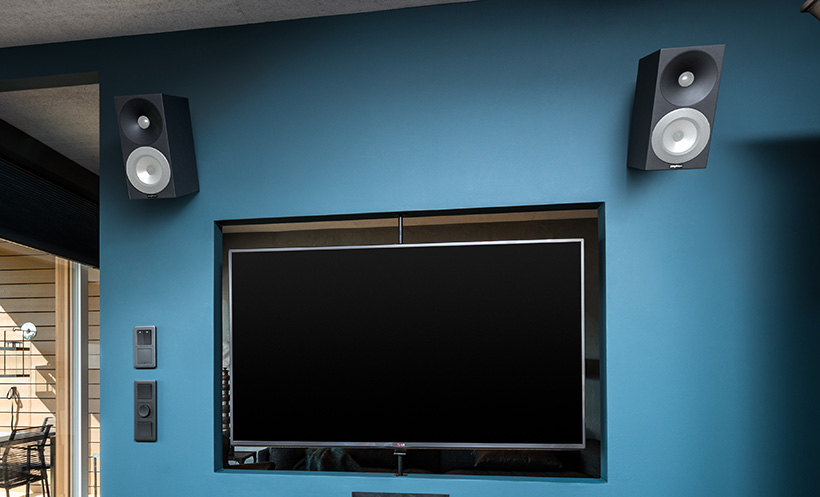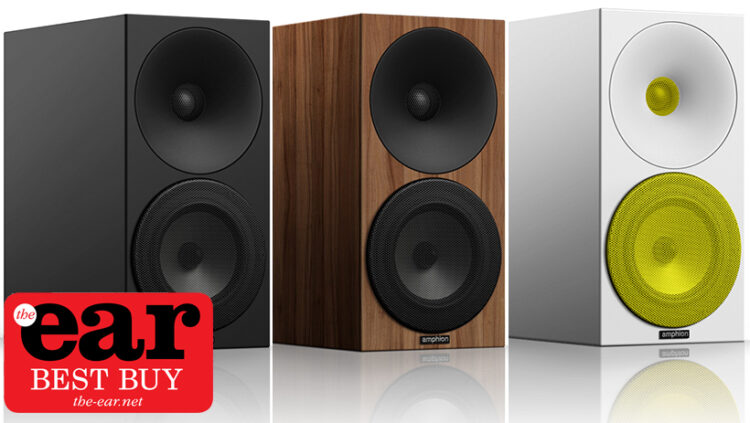Having heard loudspeakers from Finnish manufacturer Amphion at various shows around the world, I was very excited to be loaned a pair to try at home for long-term evaluation. The two-way bookshelf Argon1 was a model I enjoyed over many weeks and was particularly struck by its ease of placement, impressive bass extension from a modest-sized cabinet, and its ability to create an impressive soundstage along with decent off-axis response. We have here the second-smallest design from Amphion’s bookshelf range, above the diminutive Argon 0, and it is offered at a very competitive price.
Around since 1998 Amphion is known for not changing its models for change’s sake, thus we have here a design which has been in production for a while and is set to stick around; there’s no danger of buying something which immediately goes out-of-date as is so prevalent with some larger brands out there. There’s nothing worse than suddenly finding you’re stuck with last year’s model.
Design
This small loudspeaker is sold as a ‘bookshelf monitor’ although probably more by way of reference to its size rather than optimum placing or tonal balance, as we shall see. The Argon 1’s vented cabinet is just 31cm (12 inches) high and houses a pair of metal-coned drive units: a 130mm aluminium mid/bass combined with a 25mm titanium dome tweeter which is housed in a deep faceplate to achieve some horn-loading characteristics and modify HF dispersion. That waveguide is something of a trademark and means that the inset tweeter unit matches the size of the woofer, which is visually pleasing. While this aids directivity, it will also improve time alignment with the tweeter’s dome at the bottom of the horn and therefore behind the front panel, resulting in the two voice coils being at the same distance from the listener. Ingenious.

The claimed frequency response is an impressive 45 Hz to 25 kHz from 8kg enclosures which are slimmer than many of us are used to. The review sample came in glorious piano gloss white which made for a perfect visual match with my trusty Hegel H190 integrated amp/DAC/streamer that the speakers were more than happy to be partnered with. Foam stoppers are provided for those who wish to block the rear ports, although I didn’t find this modification necessary. To the cabinet’s rear is a single pair of rugged binding posts which are of good quality and complement the rest of the design.
One of the speaker’s hallmarks is clearly its ease of placement. I had no difficulty achieving a more than satisfactory response from the off, and the Argon 1 is likely to work in almost any room; something which cannot be said of many speakers in the class. Against the rear wall the bass response rises to add weight to the overall balance, whereas I preferred a position further away from the boundary on suitable stands where the sound wasn’t compromised at all and the weight gave way to an entertaining and well-timed LF response which encouraged my feet to tap along to the music. I experimented with some nearfield listening as well and achieved excellent results. It was notable that this speaker can achieve its best at modest, and even low SPLs. This will make them suitable for those with close neighbours or for late-night listening sessions without disturbing the rest of the household. Too many designs are optimised for higher listening levels and this is not always suitable for modern living.
Sound quality
Initial impressions count for a lot and it was evident from the first note that the Amphion 1s produce a soundstage far bigger than their cabinet size would suggest, in terms of height, width and depth. The overall balance is one of neutrality but with greater LF extension than might at first be expected given their size. Both treble and bass are as detailed and rich as the midrange, although when listening to human voice I had an urge to increase the volume in an effort to improve clarity across well-known radio drama recordings (including Poirot, Lord Peter Wimsey as well as Richard Griffiths and Frances de la Tour in The History Boys) along with some live news broadcasts.

This is a well-behaved loudspeaker with a consistent off-axis performance that was evident throughout audition. I was able to enjoy a raft of other material which showed the Argon 1s for what they are: generally well-balanced, unfussy in their placement and excellent value-for-money.
As I heard BBC Radio 3 playing a movement from Mozart’s Prague Symphony I was minded to turn to my favourite recording of his 38th in D Major (K504) with the BPO under Karajan on DG. The Amphions were able of reproducing much of the magic of this fine recording and more so than I imagined possible from a speaker at this price-point, not least from one hand-made in Finland. This is arguably Karajan at his best with the Berlin players, in a well-honed performance which was reproduced on the Amphions with clarity and authority. They managed to capture the scale and much of the dynamics of this big-band Mozart composition. The majesty of the opening Adagio filled me with a warm glow, while the Allegro was brought home, literally, with a joyous lightness of touch before the intensity of the Andante was preserved so as to make the entire an enjoyable experience of tremendous scale and dynamics.
This speaker is not perfect but then nothing this small is going to be, there have to be compromises, but the imperfections here are overshadowed by the generous attributes which the Argon 1s possess. None more so than the entertaining and well-timed bottom end and the smooth top-end, which doesn’t exaggerate treble sparkle but presents good recordings such as Tracy Chapman’s Crossroads in natural and delightfully entertaining style. Some other, older analogue recordings I played had their imperfections revealed by the Argon 1s and I could see why Amphion dub them monitors, since they can highlight deficiencies in the mix and subtle acoustic anomalies at the recording venue.
When it came to choral music the Argon 1s were clearly in their element. Stereo imaging was also first-rate here, and far better again than one might have imagined at this price. Thus, Bach’s Magnificat (BWV 243, Collegium Vocale Gent, Harmonia Mundi) was portrayed as a clean, clear and crisp sound and free from chesty compression or congestion, while also lacking unwanted sibilance or nasality. Likewise, with a 1963 recording of Verdi’s Requiem on EMI, the rendition was suitably quick and lively while capturing that communicative quality which makes music so engaging. The level of resolution is also amazing given the size of the drive units and the overall price, producing far greater detail than I expected. If we take off the VAT and dealer margin, wow – these little beauties are just such great-value.

On smaller-scale works and small jazz combos, too, the small Amphion was very much at home. The sombre opening of Elgar’s Cello Concerto (LSO under Barbirolli with du Pre on EMI from 1965) was simply sublime via the Argon 1s. They managed to unpick the musical layers and take the listener deep into the composition as the soloist was wringing every last drop from each note to reveal such a deep emotion as to make the replay most engaging. By contrast, rock recordings such as Queen’s album The Game revealed the speakers’ ability to reproduce basslines which simply improved as the volume was increased, proving that they have the ability to fill the room to intense levels if required.
Conclusion
Extremely entertaining and providing extraordinary value-for-money, the Argon 1s are clearly a fantastic little speaker across many types of music and will give hours of enjoyment. In fact this is as good an implementation of metal-coned drive units as I’ve come across. Too many designers combine such drivers to create an up-front image which places performers unnaturally close to the listener or, sometimes uneasily, in their lap.
If these are anything to go by, Amphion is a brand that needs to be better known because the sound is so entertaining, joyous to listen to. That they are easily driven and so unfussy when it comes to placement makes the Argon 1 just adorable and something of an audio bargain. They’ve been really fun to use and brought a smile to my face on track after track. The fact that they are hand-made in Finland is the icing on a very tasty cake.


